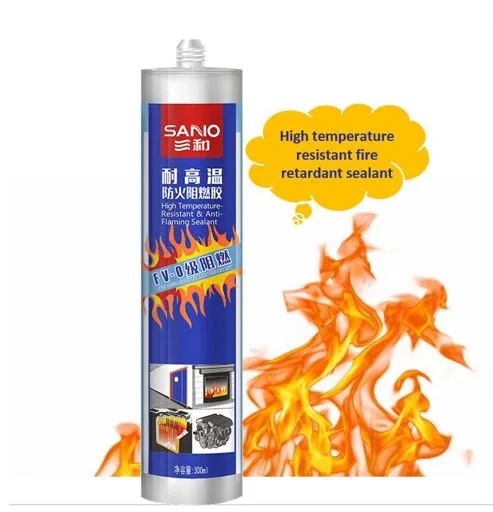Enhancing Retail Interiors: The Intersection of Flame Retardant Sealant and Jewelry Display Furniture
In industries where safety and aesthetics converge, the pairing of flame retardant sealant and jewelry display furniture might seem unusual at first. One falls into the category of structural protection and the other one is about displaying beauty. However, when functional and design come together, there are interesting ways that the two can intersect especially in places such as luxury retail stores, museums and exhibitions.
This discussion examines the role of advanced sealing solutions in safety, the role of display furniture in the context of the overall design goals, and how the combination of these two factors helps to deal with protection and aesthetics.
Flame Retardant Sealant: Safety Beyond Conventional Applications
A flame retardant sealant is a specialized material designed to resist ignition, slow the spread of flames, and maintain structural integrity in the event of a fire. It finds application in the construction industry, industrial equipment, transportation and even the assembly of electronics. Such sealants do not act as a passive barrier to heat transfer, but rather actively impede the transfer of heat and produce little smoke, giving occupants vital time to escape and emergency services time to arrive.
The performance of a flame retardant sealant depends on its chemical formulation, adhesion strength, and compatibility with various substrates. Silicone versions are flexible and polyurethane or acrylic versions can be strong adhesives to porous surfaces. These sealants are essential in joint sealing, gap seals and fire proofing around cables, ducts as well as structural members. Retail spaces where there is a lot of electrical lighting and decorative installations, the addition of such sealants during the construction stage can add fire safety without any loss to the interior design aesthetics.
Jewelry Display Furniture: More Than a Showcase
Jewelry display furniture is not simply about holding and presenting jewelry items. It is the key element of retail business. The engineering of high-quality displays focuses on the brilliance of each piece, as well as security and durability. The selection of materials, finishing, and lighting is carefully thought out to direct the attention of a customer and establish an exclusive mood.
A display that is well designed is a combination of form and functionality. Glass cases can be made of tempered or laminated glass to be safety-proof and wooden or metal frames are made to be long-lasting. The aspect of lighting is also important and is usually LED due to its energy efficiency and low heat emission quality to make gemstones and precious metals even sparklier. The design can be custom and can consist of rotating platforms, mirrored backgrounds and modular setups to fit seasonal inventory.
The durability of jewelry display furniture also involves considering environmental conditions. A busy retail environment is subject to humidity, dust and accidental impacts. Thus, the manufacturers usually choose such coating and finishes that wear well and still preserve the luxurious look with time.
Integrating Flame Retardant Sealant into Jewelry Display Furniture Design:
At first glance, there might appear to be no direct connection between flame retardant sealant and jewelry display furniture. Nevertheless, contemporary retail design usually demands the cooperation of safety engineers and interior designers. Lighting of display cases, electrical wiring of rotating stands and built-in digital screens to display video of products all have the potential to be fire hazards unless managed correctly.
In such cases, flame retardant sealants are applied to seal gaps where wires enter or exit display units, reducing the risk of flame propagation in the event of an electrical fault. This software makes sure that even complex pieces of furniture are fire safety compliant without compromising flexibility of design. High-end jewelry boutiques, especially those located in large commercial complexes, often face strict building codes that mandate fire-resistant materials in all fixtures and fittings.
Additionally, integrating safety measures like these during the manufacturing stage avoids costly retrofits later. This approach demonstrates that safety need not be an afterthought—it can be incorporated seamlessly into the initial design, enhancing the overall value and compliance of the furniture.
Material Innovation and Aesthetic Preservation:
One of the challenges in merging flame retardant sealant use with jewelry display furniture lies in maintaining visual appeal. Sealants should not interfere with the smooth lines, smooth surfaces, and smooth finishes customers get in luxury retail interiors. Fortunately, new sealant technology has provided clear or colour-matched sealants that are virtually invisible after application, as they match furniture material.
For example, when sealing joints between glass panels in a display case, a clear flame retardant sealant can be used to maintain transparency while still delivering high thermal resistance. Equally, a colored matched sealant can be utilized quietly in the edges and corners of wooden display furniture so that fire safety precautions do not affect the craftsmanship.
The possibility to change the appearance of sealants creates a chance to be creative in furniture design without the violation of safety obligations. Such integration is also an indication to the clients and regulators that the brand is concerned with style and structural protection.
Industry Trends and Future Outlook of Flame Retardant Sealant and Jewelry Display Furniture:
The demand for flame retardant sealant in retail environments is expected to grow as building codes become more stringent and as retailers recognize the importance of safeguarding high-value inventory. Luxury brands especially have a lot to lose in case of fire damage not only in the value of the product but also brand image.
Meanwhile, the jewelry display furniture industry is embracing modular and technology-integrated solutions. The electrical components needed are even more important with smart displays that have sensors, interactivity and security features, all of which are dependent on electrical components. As the concept of sustainability also has an influence on material selection, the manufacturers are investigating the use of environmentally friendly sealant formulations that do not compromise the safety requirements but are less environmentally harmful.
With the increasing overlap between these two industries, liaisons between the furniture designers and safety material manufacturers may provide innovative solutions to meet several requirements at the same time. This may incorporate built-in cable management systems which are already sealed with fire resistant materials or built in display units which are already certified with fire safety before installation.
Conclusion:
The pairing of flame retardant sealant and jewelry display furniture illustrates how safety and luxury can coexist without compromise. The incorporation of superior safety materials in furniture design is a tactical decision in the high-end retailing environments where customer experience and asset protection are of utmost importance. It increases compliance, secures valuable assets and puts staff and customers at ease.
By understanding the role of flame retardant sealants and their discreet integration into elegant display solutions, retailers can ensure that every element—from the structure of the store to the sparkle of the products—reflects both excellence and responsibility.






